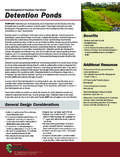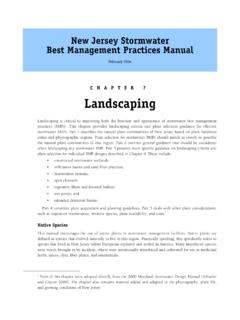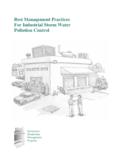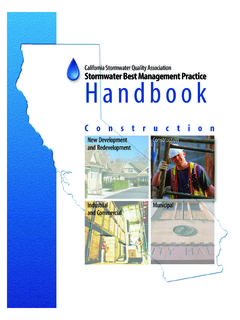Transcription of GENERAL PERMIT FOR THE DISCHARGE OF …
1 1 79 Elm Street Hartford, CT 06106-5127 Affirmative Action/Equal Opportunity Employer GENERAL PERMIT FOR THE DISCHARGE OF stormwater FROM SMALL MUNICIPAL SEPARATE STORM SEWER SYSTEMS REISSUANCE WITH MODIFICATIONS fact SHEET GENERAL PERMIT Background: The DEEP stormwater GENERAL PERMIT program was developed pursuant to EPA s stormwater Rule and Connecticut s stormwater permits are issued under the authority of the National Pollutant DISCHARGE Elimination System (NPDES) and Connecticut GENERAL Statutes Section 22a-430 and 22a-430b. Phase I of the EPA stormwater Rule was published in 1990 and addressed runoff from medium and large municipal separate storm sewer systems (MS4s) with populations greater than 100,000 as well as runoff from industrial and construction activities. Phase II of the stormwater Rule was published in 1999 and addressed runoff from small MS4s with populations less than 100,000. The DEEP first issued the GENERAL PERMIT for the DISCHARGE of stormwater from Small Municipal Separate Storm Sewer Systems (MS4 GENERAL PERMIT ) on January 9, 2004 under this Phase II rule.
2 The GENERAL PERMIT has been reissued, without modifications, since 2004. The purpose of the MS4 GENERAL PERMIT is to protect waters of the state from urban stormwater runoff through municipal separate storm sewer systems. EPA defines a regulated small MS4 as a municipality that owns and operates a storm sewer system in an Urbanized Area (UA). Urbanized Areas are defined by the federal Census Bureau and consist of densely populated areas surrounding urban centers. The criteria for designating UAs are developed by the Census Bureau and maps of UAs are published after each decennial census. The original maps governing the 2004 GENERAL PERMIT were based on the 2000 census. The most recent maps reflect the results of the 2010 census. EPA does not require coverage of municipalities outside of Urbanized Areas but allows the permitting authority (DEEP) to designate additional MS4s outside of Urbanized Areas. There are 113 MS4s, regulated by virtue of having Urbanized Areas, authorized under the current GENERAL PERMIT .
3 The requirements of the current GENERAL PERMIT include registration to obtain PERMIT coverage, development and implementation of a stormwater management Plan and monitoring of six stormwater outfalls once a year during a rain storm. The stormwater management Plan is the cornerstone of the MS4 GENERAL PERMIT . It is a document prepared by the MS4 that contains information on its stormwater and municipal infrastructure along with Best management Practices (BMPs) to reduce and/or eliminate the DISCHARGE of pollutants through the storm sewer system to the Maximum Extent Practicable (MEP). MEP is the standard promulgated in EPA s Phase II rule that MS4s are required to meet. The definition of MEP is to reduce and/or eliminate to the extent achievable using control measures that are technologically available and economically practicable and achievable in light of best industry practice. EPA states that the 2 MS4 GENERAL PERMIT fact Sheet 1/13/16 MEP standard for MS4 discharges is an iterative process consisting of a municipality developing a program consistent with specific PERMIT requirements, implementing the program, evaluating the effectiveness of BMPs included as part of the program, then revising those parts of the program that are not effective at controlling pollutants, then implementing the revisions, and evaluating again.
4 This process continues until the goal of meeting water quality requirements is achieved. The BMPs in the stormwater management Plan are organized into six categories of Minimum Control Measures: public education and outreach; public participation; illicit DISCHARGE detection and elimination (IDDE); construction stormwater management ; post-construction stormwater management ; and pollution prevention and good housekeeping. Each of these categories includes several BMPs to implement the control measure. Certain BMPs are required and the PERMIT provides for additional BMPs to be implemented, as necessary to address pollution, at the discretion of the MS4. The new MS4 GENERAL PERMIT provides significantly more detail on the requirements and implementation of the six Minimum Control Measures as well as expanding certain requirements. A summary of the more significant modifications follows. Changes in Coverage: The original Phase II stormwater Rule required GENERAL PERMIT coverage for MS4s with Urbanized Areas based on the most recent decennial census.
5 The 113 MS4s currently covered by the current GENERAL PERMIT were determined using the 2000 census, which was the most recent at the time of issuance. Based on the 2010 census, the new GENERAL PERMIT will add 8 more towns (Brooklyn, Haddam, Killingly, Mansfield, New Hartford, Plainfield, Sprague and Willington) to this list. The Phase II stormwater Rule also required coverage of state and federal institutions that it called non-traditional MS4s. The new MS4 GENERAL PERMIT now includes these institutions such as state and federal prisons, colleges, hospitals and military facilities as MS4s covered by the GENERAL PERMIT . Compliance timelines for most elements of the six Minimum Control Measures allow for more time for these new MS4 permittees (institutions and 8 new towns) to comply. The current MS4 GENERAL PERMIT requires implementation of the six Minimum Control Measures throughout the municipality with some additional or alternate measures within the UA portion of the MS4.
6 Under the new MS4 GENERAL PERMIT many measures are required only within the UA and those areas outside the UA that DISCHARGE to impaired waters or from areas with Directly Connected Impervious Area (DCIA) exceeding eleven percent (11%). The GENERAL PERMIT refers to these areas as priority areas . Public Education and Outreach: This minimum measure is substantially similar to the current PERMIT but provides more detail on the types of outreach required and the means of conducting the outreach. It specifies outreach targeting pet waste, application of fertilizers, herbicides, and pesticides, and impacts of illicit discharges and improper disposal of waste into the MS4. Outreach materials can be developed or acquired from various sources such as governmental agencies, academia, and/or environmental advocacy organizations and can be disseminated in numerous ways such as flyers, 3 MS4 GENERAL PERMIT fact Sheet 1/13/16 brochures, door hangers, television public service announcements, and web-based tools.
7 This minimum measure also dictates a timeline for implementation of this program. In addition to these standard requirements, this measure includes additional targeted efforts to address water quality impairments. Public Participation: As with public education and outreach, this measure is not significantly different from the current GENERAL PERMIT but the new GENERAL PERMIT provides additional detail on the implementation of this requirement. It requires the MS4 to publish a public notice of the availability of its stormwater management Plan and Annual Report for public review. It recommends locations for the plan to be available such as the MS4 s main office, a local library or other central publicly available location and also a URL where the information may be accessed electronically. This measure requires a minimum of a 45 day comment period to solicit and receive public comment on the Annual Report. The MS4 is also encouraged to enlist local organizations to help implement the elements of its stormwater management Plan.
8 Illicit DISCHARGE Detection and Elimination (IDDE): This section addresses how the MS4 identifies, traces and eliminates non- stormwater discharges to its storm sewer system from sources such as sanitary sewer cross-connections, illegal dumping, industrial and commercial wastes, floor drains, animal wastes, lawn management chemicals and wastes. While the overall requirements of this section remain similar to the current GENERAL PERMIT , the new GENERAL PERMIT provides considerably more detail regarding the legal authorities that are required to implement the IDDE program, the protocol for actually performing the field work to detect and eliminate illicit discharges, mapping requirements, citizen reporting provisions and the timeframe for IDDE program completion. The requirements of this measure are mandated only in the priority areas. The new GENERAL PERMIT also contains new requirements for record keeping to document the progress of the IDDE program.
9 In addition to these standard requirements, this measure includes additional targeted efforts to address water quality impairments. Construction Site stormwater Runoff Control: While containing all of the requirements of the current GENERAL PERMIT , this section of the new GENERAL PERMIT provides significantly more detail. A good deal of this detail is outlining the legal authorities the MS4 must develop to manage construction site runoff within its jurisdiction. Most of this legal authority will reside within the regulations and policies of the land-use commissions for the MS4. This section will require consistency with the Connecticut stormwater Quality Manual in addition to the 2002 Guidelines for Soil Erosion and Sedimentation Control already referenced in the current PERMIT . More detail is provided for construction review and inspection, notification of requirements of the DEEP construction GENERAL PERMIT , public involvement and long-term maintenance of stormwater treatment ponds.
10 There is also new language requiring the MS4 to develop a plan outlining how all MS4 departments and boards with jurisdiction over land disturbance and development projects will coordinate their functions with one another. 4 MS4 GENERAL PERMIT fact Sheet 1/13/16 Post-construction stormwater management : The new GENERAL PERMIT expands this section to require MS4s to update their land-use regulations to include Low Impact Development (LID) measures, post-construction stormwater retention and other elements of the GENERAL PERMIT for the DISCHARGE of stormwater and Dewatering Wastewaters from Construction Activities, effective October 1, 2013 (construction GENERAL PERMIT ) in addressing applications for new development and redevelopment. In addition, the MS4 must develop a program to ensure the inspection and long-term maintenance of existing stormwater facilities under the jurisdiction of the MS4 as well as provide, through its land-use regulations, requirements for long-term maintenance of stormwater management measures in new applications for development.
















